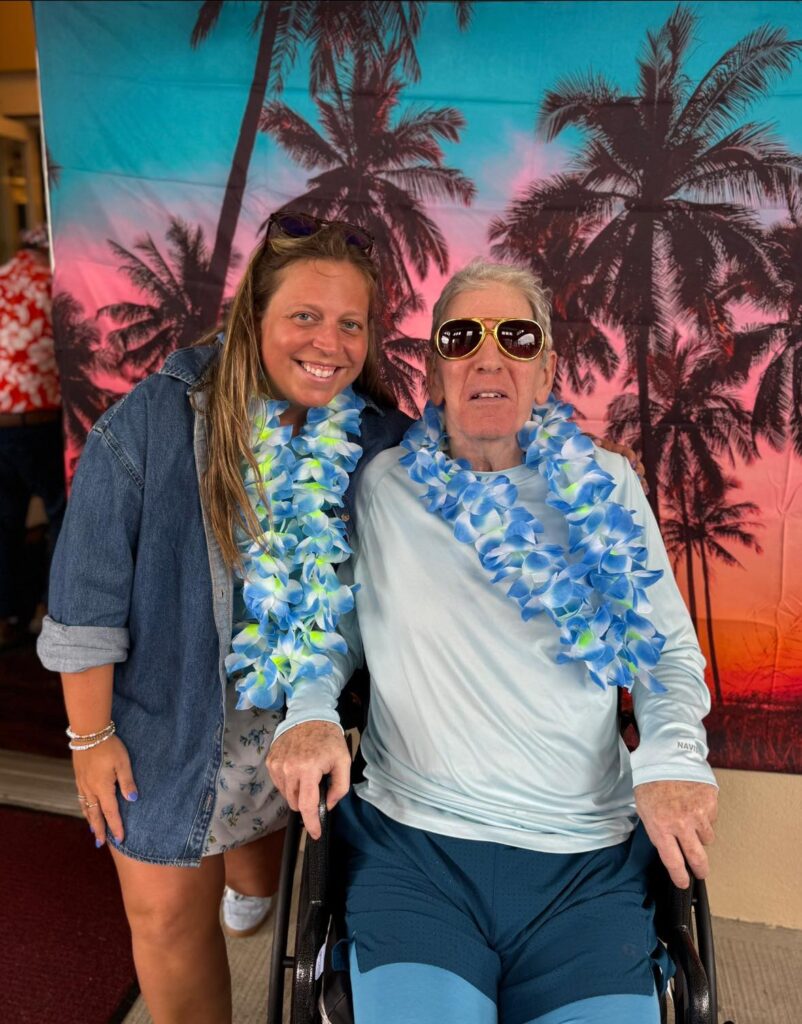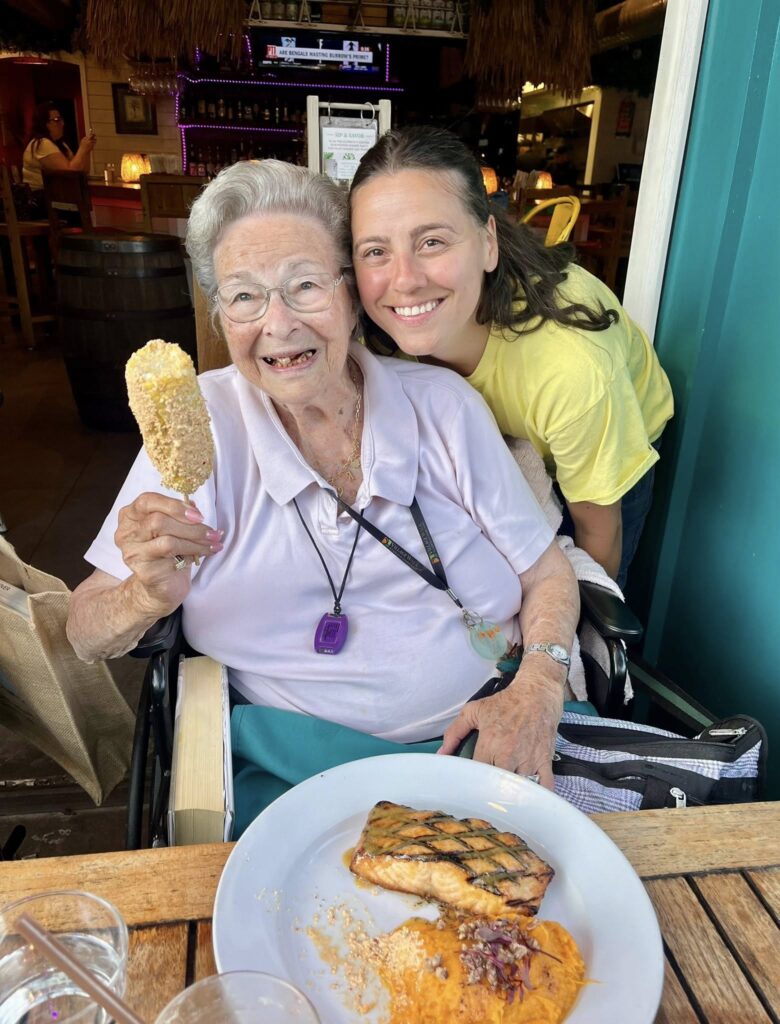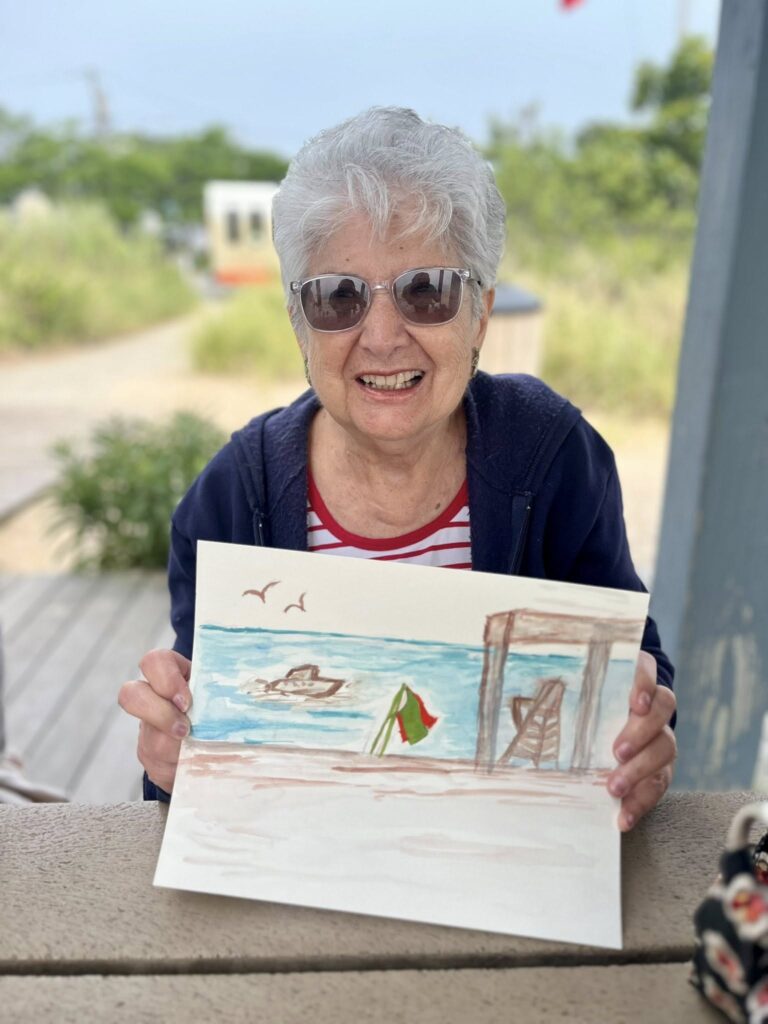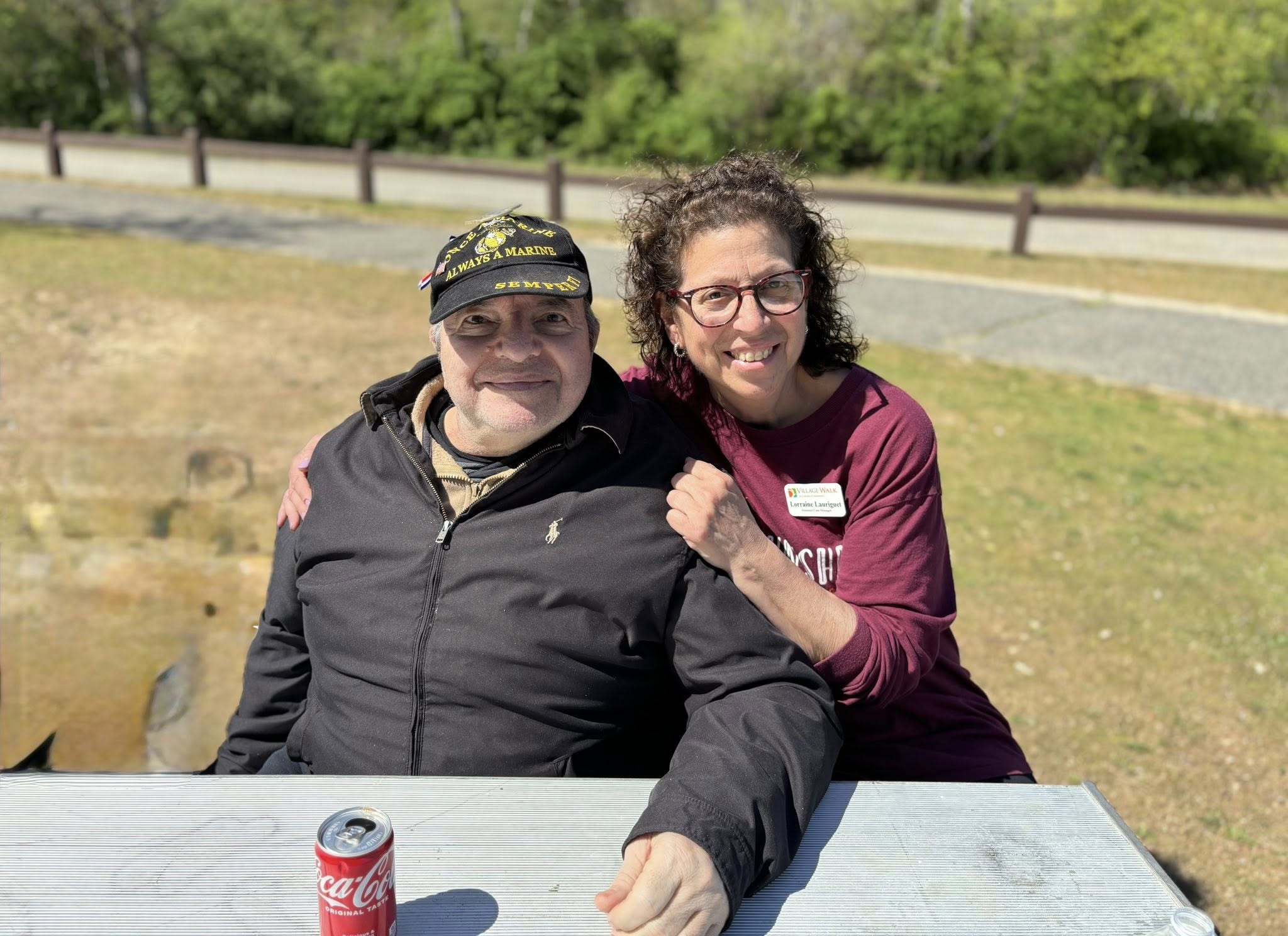Considering moving you and/or your loved ones to assisted living? Consider this: the average life expectancy in assisted living facilities is about 22 months, with 60% of residents transitioning to more skilled care after (American Health Care Association/ National Center for Assisted Living, 2025).
When seniors don’t receive the right care, they may reduce their chances of living a long, happy, and healthy life. So, we understand if you’re looking to make sense of the average length of stay in an assisted living facility.
But what factors affect the average length of stay and life expectancy of a senior in an assisted living facility? What other options exist for those who’ve moved on from assisted living and need extra care to thrive?
Village Walk here: our senior care specialists pooled our resources and created this article to answer the question, “What’s the average life expectancy and length of stay in an assisted living facility?”
In this article, we’ll discuss:
- The factors that affect the length of stay and life expectancy of seniors in care facilities
- Three key factors that affect the average length of stay in an assisted living facility (and the reasons behind these factors)
- Two potential options for moving out of assisted living, memory care and skilled nursing care
- What’s included with receiving village-wide care for a loved one
- The factors that affect the length of stay and life expectancy of seniors in care facilities
- Three key factors that affect the average length of stay in an assisted living facility (and the reasons behind these factors)
- Two potential options for moving out of assisted living, memory care, and skilled nursing care
- What’s included with receiving village-wide care for a loved one
Factors that affect the life expectancy of seniors in care facilities
| 1. The types of healthcare provided 2. The types of support for activities of daily living (ADL) 3. The cost of care 4. The levels of care provided at the facility 5. The need to transition to higher levels of care |
The average length stay in an assisted living facility

As mentioned above, the average length stay in an assisted living facility is about 22 months. With that being said, this number varies depending on a few different factors:
- The amount of support that the facility provides
- The types of care the family wants provided
- Financial resources available: money can affect how long someone stays in an assisted living setting
- The intensity of health issues the resident faces: individuals with more serious health care concerns often need extra levels of care in an assisted living facility.
As such, not all seniors live the same lifestyles, so a great deal needs to be said about the dietary, lifestyle, and activities that occupy a person’s life.
3 factors that affect the average stay (or expected stay)

We’ve noticed that three factors tend to affect the time a senior lives in assisted living facilities. Those three factors include the following:
- Seniors are choosing to move out of their homes into long-term care later
- Seniors who choose assisted living long-term care services are often dissatisfied with their current level of care
- The average monthly cost of assisted living becomes an issue.
Let’s dive into each in greater detail in the sections below.
1. More seniors are opting to move later
We understand that moving out of a cherished home after years can be, well, a lot of things. Stressful, scary, and challenging are just a few words that describe the move.
Many seniors are either opting for longer in-home care, don’t see a need to move, or prefer to stay at home. Oftentimes, seniors prefer to live at home because they feel they can meet their current needs to a greater extent at home.
More often than not, many prefer the lifestyle they live at home and feel that moving to an assisted living facility might change their ability to be independent and live as they please.
Our team honors, respects, and nurtures our residents’ desires to live independent, full, and quality lives. Our Village provides top-quality care in a safe, comfortable environment where you can feel free to live as you wish or in the comfort of your peers in a warm, compassionate environment.
Nevertheless, many seniors also feel they may not want to move to an assisted living facility because they’re dissatisfied with their current level of care. We’ll turn to this topic next.
2. Seniors may be dissatisfied with their current level of care
Families and seniors often move to other care facilities when they’re not satisfied with their care options. More often than not, families leave to go to a different community or to receive a different type of care.
Part of determining the right type of care for a senior is to consider what types of care the facility can offer. One reason that seniors often leave is because they’ve found that their current care community isn’t able to provide for their evolving needs.
The best assisted living communities offer different types of care levels and opportunities for seniors to engage in their favorite activities and hobbies.
In general, senior care facilities tend to provide three different levels of care:
- Low-level care
- Mid-level care
- High-level care
Someone receiving level one, low-level care can usually perform most ADLs on their own, but they might need gentle reminders to do so.
A person receiving mid-level, level 3 care might need help with a few ADLs. For example, they may be able to walk on their own, but they’ll need help taking a bath.
What’s more, they may also need help with balance, as they’re prone to falls.
Finally, residents who receive high-level care need help with everyday tasks. These residents may need help from more than one caregiver and need reminders for most ADLs.
When a senior needs extra care beyond high-level care, sometimes all that’s needed to make a change is to know the difference between assisted living and memory care and make the choice that’s right for the senior. And the best assisted living facilities provide different plans and pricing to ensure residents can live in a place that includes everything they need.
3. Money becomes an issue
Speaking of plans and pricing, we understand that money can be a touchy yet important subject when considering the average length of stay at an assisted living care community.
Insurance doesn’t often cover the specific facility or care that’s needed, or the rise and fall of the market’s prices means families and seniors must seek more affordable care options.
With that being said, assisted living is one of the most affordable care options on the market when compared to skilled nursing care, memory care, and in-home care. The best assisted living communities provide financial aid to support individuals with their evolving care needs.
The average cost of care
According to a 2024 Genworth and CareScout study, the average monthly cost of a private, one-bedroom apartment in an assisted living community was $5,900.
This number includes amenities such as the following:
- Room and board
- Utilities
- Three meals prepared daily
- Medical supervision
- 24/7 security and staff support
- Help with various activities of daily living (such as bathing, grooming, medicine management, and more)
- Recreational activities
- Trips and outings to local experiences and storefronts
- Community amenities
- Housekeeping
- Personal support
- Transportation to and from appointments
Given the $5,900 monthly fee, assisted living tends to be one of the most affordable care options for those who need long-term care.
Other potential options for moving out of assisted living

Nevertheless, some seniors opt for other care options beyond assisted living. One of the factors that influences the decision to change is that seniors need care that extends beyond the scope of the assisted living community’s care services.
Many people who live in assisted living communities who need more care tend to move to skilled nursing facilities or nursing homes. Another popular option is memory care.
Like Village Walk, many care communities offer both assisted living and memory care on the same campus. For example, in our community, one wing of our assisted living neighborhood is for those who need minimal support for ADLs. We reserve the other wing for individuals with memory loss, Alzheimer’s, and other forms of dementia.
Memory care for seniors
Memory care is perfect for individuals who want all the benefits of independent living but still receive care and support for memory loss-related conditions and dementia. Memory care communities provide quality healthcare for seniors and safe environments for ambulation.
Cultivating safe spaces for living and independence is what memory care is all about.
For example, at Village Walk, each resident is encouraged to place cherished items in a memory box next to their door to familiarize themselves with their surroundings and feel at home. We also offer a variety of health and wellness activities that support the eight dimensions of wellness, ensuring lasting comfort, peace of mind, and vitality for all our residents.
Skilled nursing care for seniors
Skilled nursing care is similar to memory care. Yet, it differs in that residents receive more intense medical. With skilled nursing facilities, residents have 24/7 access to nurses.
These nurses provide specialized care for each resident. These types of facilities are apt for individuals who need supervision for the immediate future, often after a medical accident.
As such, they tend to be more expensive than memory care and assisted living.
As such, caregiving in a skilled nursing facility tends to be more expensive than in memory care or assisted living.
Did you know?

Did you know that aging in place can be more expensive than moving to a senior living community. Modifying your home, hiring a caregiver, and getting help with day-to-day chores are expenses that add up.
Curious to see how these costs compare to the cost of aging at home? Visit over to our Facebook page ,and check out our post that compares the cost of moving to a care community versus living at home.
Need village-wide care for your loved one near Patchogue, NY?

Though the average length of stay in an assisted living community is about 22 months, the devil is in the details. The reason is that many people who move into an assisted living community tend to need more help to live safely and with the appropriate level of care as they age.
So, in reality, the average life expectancy for assisted living residents is much longer than 22 months.
In an ideal situation, both continuing care and memory care are provided in the same community and facility. In our opinion, doing so helps bring the community together and create a more homey, inclusive environment.
That’s how we operate.
At Village Walk, residents who need extra care for memory loss — and residents who need low levels of care — live in the adjacent neighborhoods. Our memory care and assisted living spaces are perfect for the older adult who wants to age with grace.
Plus, our senior care specialists have more than 20 years of experience providing dedicated, compassionate, and loving care to older adults. In other words, our caregivers love working with older adults.
Whether you and/or your loved one are looking for a place to call home where you can come and go as you please — or if you’re looking for a supportive, safe, and nurturing environment for a loved one with dementia — you’ll find both under the same roof here at Village Walk.
To learn more about our Village’s assisted living and memory care offerings — or to schedule a tour of our community — don’t hesitate to contact our knowledgeable and friendly senior concierge staff.
We’d be happy to help (and lunch is on us!). Until then, we wish you the best of luck on the journey ahead!








